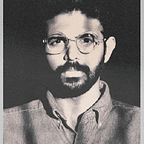Twitter NFT Verification — Colliding the Worlds of Art and Digital Identity
Art as Social Sculpture
I n the 1970’s, the influential German Artist, Joesph Beuys developed a theory of ‘social sculpture’ based on an idea that everything is art and everyone has the potential to be an artist. He believed that life is a social sculpture that everyone helps to shape and therefore saw art as a potential medium that brought together an aesthetic practice along with views of an idealistic utopian society. While he spent his lifetime experimenting with this extended concept of art for social change, I suspect that his environment was not ready for this idea to be realized in the way he imagined. In other words, given the technological restraints of the time, there was no medium that would enable the public to participate en masse in such a practice.
However today, things are different. We have already seen how the internet has allowed for mass coordination of activities for social change and now with the evolution of NFTs as digital art it has brought his notion of “everyone is an artist” to a literal sense in that it allows anyone to tokenize anything on a global network to further a particular idea or vision of society. An example of this would be Gary Vaynerchuk, who would not be considered an artist in a “traditional sense”, yet his NFT project, VeeFriends, has enabled him to use art as a way to empower his 2.4 million (on twitter) strong community. What we are seeing now is the birth of an expanded concept of art taking shape and we are only beginning to scratch the surface.
I have always felt that as a digitally native medium, NFTs represent something different from what we have so far come to understand as ‘digital art’. One of the key reasons for this is that the culture of experiencing NFTs is uniquely online and closely linked to social media therefore making the artwork omnipresent. In other words, wherever the owner goes, so does their art. This becomes evident as we see the common practice of NFTs being displayed as profile pictures on social media platforms.
The physical walls of galleries have been replaced by digital screens of the internet.
In any other earlier iteration of digital art, this would be the extent of its use — as a mere display mechanism. However NFTs being different, its back end code or immutable record of ownership on the Blockchain adds another layer of functionality to the artwork. In an earlier essay I argued that it provides the ability for it to become a verifiable tool for the future of digital identity. By verifying the artwork, one can also verify its owner without any other information. Imagine a future where you show your favorite artwork as proof of identity while boarding a flight or opening a bank account. The medium has somehow collided the worlds of digital identity and art thereby creating an environment where the circular placeholders found on social media platforms, once meant to reveal your identity, have been replaced by NFTs as a way to alter or hide your identity altogether. The concept of ‘Pseudonymity’, a concept put forth by Balaji Srinivasan, the former CTO of Coinbase comes to mind — but more on that later.
It is interesting to see how this idea evolves but with Twitter recently announcing a NFT verification feature, it seems that we have already begun this process of linking art to identity and perhaps the start of a network of social sculptures.
*This essay was originally published on 1:11 Journal
About Harsha Bis:
Harsha Biswajit is a new media visual artist currently living and working in Berlin. His work primarily explores transformations brought about by technology. Before he entered the world of art, he was once dabbling with economics before deciding to make the dive as a full time artist in 2010.
You can find him on:
